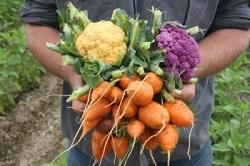
The Fall and Winter Garden
The Fall and Winter Garden

There are a myriad of publications and articles to answer your questions:
Q: What cool-weather vegetables can I plant in Sonoma County and when?
A: “Year-Round Food Gardening in Sonoma County” is organized by planting windows. Look at crops on page 2 that are designated “C” (cool weather).
Q: What is the first average frost date for my area?
A: The first average frost date for seven county weather stations is summarized in “First and Last Frost Date in Sonoma County.” This is based on 30 years of past weather data and should be weighed along with this year’s weather prediction for your area.
Q: What cool-weather vegetables can I grow in a small space such as a raised bed or container?
A: See “Focus on Fall/Winter Vegetables” for a sample 4’x8’ planting bed plan as well as gardening information (including container sizes) for the highlighted crops.
Q: How do I select a crop variety and how can I find more detailed garden information for each crop?
A: See “Choosing Vegetable Varieties.” In addition, individual crop articles include varietal suggestions as well as planting, maintenance and harvesting guidance.
Q: The variety I want to grow is not available from my local nurseries. Now what?
A: Buy seeds online this month. “Vegetable Seed Sources” gives you many seed-buying options. If it seems as if there are too many options, narrow it to Northern California sources. You can start seed indoors 6 to 8 weeks in advance of your planting date and many crops can be direct seeded in the garden. “Year-Round Food Gardening in Sonoma County” identifies which crops can be direct-seeded.
Q: I’m new to food gardening. How do I begin?
A: “Growing Vegetables” is a great starting point.
The Master Gardener Food Gardening Specialists maintain a demonstration food and pollinator garden at Bayer Farm Community Garden, 1550 West Avenue, Santa Rosa. The garden is open for viewing by the public during daylight hours, seven days per week. If you drop by on Friday morning, you’re likely to find Food Gardening Specialists working in the garden. We hope to see you in the garden or at one of our workshops.






